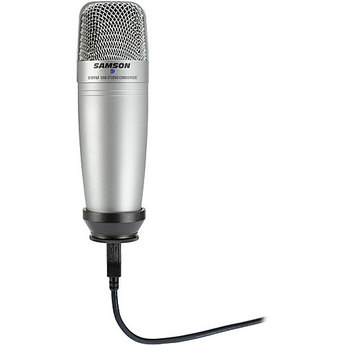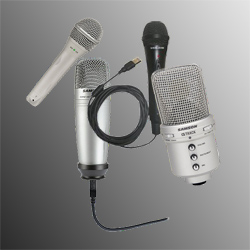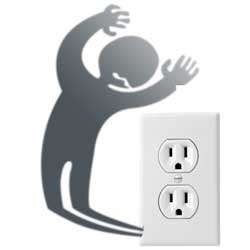 Recently I posted something called Phantom Power – A Dizzying Description in which I called attention to the fact that audio recording terms like phantom power are often hard to describe if you try to get into the details. I had asked someone to put together a 400-word essay on it for me and was stunned with how academic (to put it euphemistically) it came across. My eyes glazed over halfway through.
Recently I posted something called Phantom Power – A Dizzying Description in which I called attention to the fact that audio recording terms like phantom power are often hard to describe if you try to get into the details. I had asked someone to put together a 400-word essay on it for me and was stunned with how academic (to put it euphemistically) it came across. My eyes glazed over halfway through.
I went ahead and posted those 400 words for those who are more academically and technically inclined, but promised a now-what-is-it-really-and-only-tell-me-what-I-need-to-know post on phantom power very soon afterward. This is that post.
Okay, so to cut right to the chase – there are basically 2 types of microphones, dynamic and condenser. Ribbon mics are sometimes called a 3rd category but really are a variant of the dynamic.
What you need to know:
Dynamic mics don’t need electric power. Assuming the thing you plug them into – a mixer or PA of some sort – is plugged in, all you have to do is poke the microphone cable from a dynamic mic into a mixer and you’re good to go. That type of mic works by the sound coming into it (your lovely voice, perhaps) physically moving the parts (magnet and wire coil) inside. Those movements are then converted to an audio signal.
Condenser mics DO require electricity beyond what a plain old mixer or other interface can provide. That’s because condenser mics convert air movement (caused by your lovely voice) to audio in a different way (changing capacitance if you must know, which you don’t;)). That different way needs about 48 volts of electricity just for the mic to work.
As you may have guessed by now, that 48 volts of extra juice is called phantom power, probably because it comes into the mic not via the way you power up most things, namely with a plug of some sort. Phantom power comes into the mic through a mixer or interface by flipping a switch on the mixer. Sometimes the switch is labeled “phantom power.” But often you’ll just see “48V” or something similar on the device, usually next to a switch and an indicator light (so you know if it’s on or off).
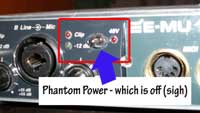 It is not at all uncommon (meaning I do this all the time!!) to plug the condenser mic in and get all ready to record only to find there is no sound coming through the mic because someone (me) forgot to turn on phantom power. You have been warned.
It is not at all uncommon (meaning I do this all the time!!) to plug the condenser mic in and get all ready to record only to find there is no sound coming through the mic because someone (me) forgot to turn on phantom power. You have been warned.
One other thing you should know. It is possible to carry your own phantom power, which is handy if you are a musician doing gigs. This just happened to me a few months ago. I was at a venue that used a condenser microphone on-stage. Their amp died and the owner came back with a combo mixer/amplifier thing that is very useful for live PA stuff. But since for live PA stuff, most people use dynamic mics, there was no phantom power on the mixer. We couldn’t use it for the venue.
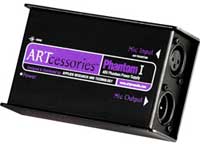
But a musician friend of mine had a portable phantom power unit similar to the ART Phantom I unit pictured on the left. All you need then is an outlet and an extra mic cable. We just plugged the condenser mic into the ART, then plugged the extra mic cable into the output of the ART and into the mixer. Voila! Phantom power. The day was saved.
So that is all you really need to know about phantom power. Condenser mics need it. Dynamic mics don’t. If you are all set up to record (or play live) with your condenser mic and you are getting no sound, chances are good that you forgot to turn on the phantom power.
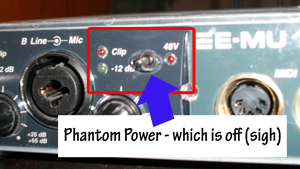 Phantom power is not supernatural, nor is it anything to do with with Andrew Lloyd Weber (snicker). So that is what it isn’t. What it is can be – gasp what a surprise – a bit confusing and “techie” sounding when someone tries to explain it. I asked someone for 400 words on what phantom power is and below was the result. Hint: take a big hit on your coffer, soda or 5-Hour Energy drink before proceeding. I will put up a now-what-is-it-really-and-only-tell-me-what-I-need-to-know
Phantom power is not supernatural, nor is it anything to do with with Andrew Lloyd Weber (snicker). So that is what it isn’t. What it is can be – gasp what a surprise – a bit confusing and “techie” sounding when someone tries to explain it. I asked someone for 400 words on what phantom power is and below was the result. Hint: take a big hit on your coffer, soda or 5-Hour Energy drink before proceeding. I will put up a now-what-is-it-really-and-only-tell-me-what-I-need-to-know  When you record your voice, are you happy with the result? Well, let me ask it a different way because a lot of people simply hate the way their voice sounds to them when they hear it played back on a recording, regardless of the audio quality. That’s a different thing. I’m referring to whether the sound is nice and clear without a lot of noise in the background.
When you record your voice, are you happy with the result? Well, let me ask it a different way because a lot of people simply hate the way their voice sounds to them when they hear it played back on a recording, regardless of the audio quality. That’s a different thing. I’m referring to whether the sound is nice and clear without a lot of noise in the background.

